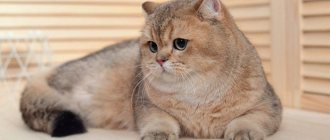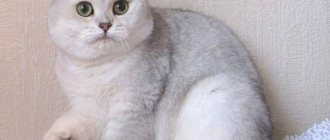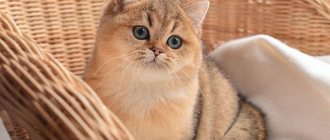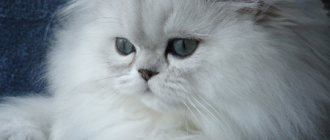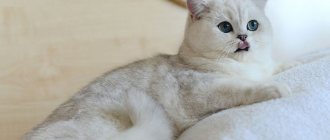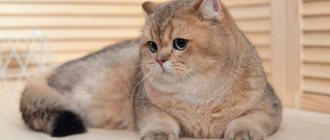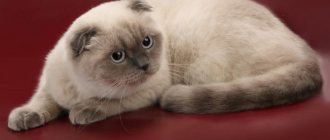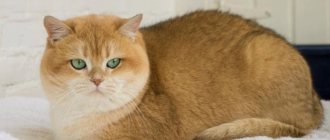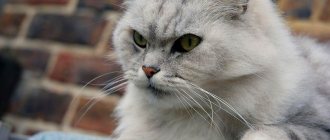5285Administration
The silver chinchilla is a unique cat. She is distinguished not only by her chic appearance, but also by her “golden” character. It is difficult to find a smarter and more intelligent animal. Many people think that chinchilla is a breed. Actually, not quite like that.
We are talking about a specific color that is found among the British, Persians, and also (albeit much less frequently) among the Scots. It is on this basis that cats are grouped into one group, the representatives of which, in addition to the color of their fur coat, have some other common features.
© shutterstock
Maintenance and care
- Fur care. Representatives of any variety should be combed a couple of times a week using a furminator according to hair growth and in the opposite direction. When tangles appear in the Persian species, they are cut off.
- Proper care of the face, for which a damp cloth is used. The eyes require daily rubbing with clean boiled water or chamomile infusion, and the ears require cleaning with a cotton swab and Vaseline oil.
- Perform a manicure a couple of times a month and have your own place with a scratching post.
- Providing water treatments. The best option is to use dry shampoo.
- Dental hygiene using special cleaning products and special dry food to remove plaque.
- Conclusions for a walk. It is ideal to accustom this cat to a harness from childhood and wear a collar against ticks and fleas, which will ensure both a pleasant process and safety.
A well-thought-out diet, which necessarily includes elite-class cat food.
In addition, an important component is the consumption of ordinary products:
- meat by-products,
- low-fat fermented milk products,
- boiled sea fish,
- scrambled eggs,
- vegetables and herbs in combination with protein foods.
It is necessary to keep your pet healthy and visit the veterinarian regularly. There are some diseases that require immediate treatment - retinal atrophy, problems with the kidneys and the cardiovascular system.
With careful attention from the owners, representatives of the golden chinchilla breed will live up to 15 years at home.
Hygiene
The chinchilla cat quickly learns to use the litter box. Sand or filler is changed frequently. If the animal feels that the litter is stale, it will find a corner and relieve itself there. Don't scold the British in this case.
Ears and eyes require special care. The ears are cleaned with a cotton swab moistened with warm water once a week or as they become dirty. The eyes are wiped with a cotton pad soaked in warm water. You can use wet wipes for this if they do not contain fragrances or other synthetic additives. They can harm your cat's mucous membranes.
The claws are cut off as needed using a nail clipper. If they peel off, it means that the diet requires correction and the chinchilla does not receive the necessary nutrients. To keep claws in good condition, make a scratching post at home.
Persian chinchilla cat
Royal appearance and noble manners make animals of this breed aristocratic in comparison with other felines. The Persian chinchilla has large green eyes and a special color. The majestic animal has a calm disposition and extraordinary intelligence.
It is curious, active, independent - if the owner does not have time to pay attention to the pet, the pet will occupy itself with important cat matters.
The breed has its own characteristics:
- Dark-lined eyes, lips, tip of the nose.
- Long, soft coat with a unique color.
- Luxurious bushy tail.
- Various coat colors.
Choosing a kitten
There are quite a lot of advertisements from private owners on websites and electronic boards with offers to choose a chinchilla cat. They offer to buy a British shorthair chinchilla cat for almost pennies: from 1-2 thousand rubles. Usually for this price you get a pet without documents or pedigree.
The buyer cannot be sure of the baby’s excellent health and does not know in what conditions the kitten grew up before the sale. Unscrupulous sellers breed incompatible samples and do not monitor the breed standard. All this leads to disastrous consequences: illness and death of animals.
At a young age, it is not clear what color a cat will have. The seller will try to assure the presence of this or that breed, and on an older ward it will be difficult to see the supposed promised signs of the animal’s standard. The formation of the animal is completed by 1 year and 6 months of life.
Therefore, it is necessary to contact nurseries and clubs, experienced breeders. Advantages of a kitten purchased from a nursery:
- a metric is provided;
- you can see the baby’s parents: in the nursery or from a photograph, evaluate their appearance and behavior;
- the animal will receive all vaccinations strictly according to age;
- the pet will be treated for helminths;
- the baby is trained to the tray;
- the baby is trained in hygiene skills;
British chinchillas quickly get used to going to the toilet in a designated place.
The price of a kitten from an experienced breeder consists of the cost of caring for the animal, purchasing medications and household products. Owners travel abroad for some representatives of the breed: travel plus hotel accommodation require considerable expenses. Participation in exhibitions and mating, selection of a partner for crossing - all this involves costs, sometimes not only material, but also emotional. Every baby is loved and the fate of every member of the nursery worries the owner.
At what age is it better to adopt a kitten?
Before 2 months, professional clubs do not offer kittens for sale. Until this time, the baby should be with the mother. The best food for a newborn kitten is cat's milk. A baby who was taken away from a cat prematurely is not psychologically ready for independent life. Nursery staff jealously monitor the date of the expected departure of the ward to a new habitat. To prevent painful situations, it is unacceptable to take animals away immediately after birth: this will lead to the death of the pet.
It is not difficult to find a silver British chinchilla kitty in a nursery at a cost of 25-35 thousand rubles. Adult cats that do not participate in exhibitions due to age and have completed their breeding career are offered for a symbolic amount, sometimes in the region of one thousand or two thousand rubles. But it will be a well-groomed, vaccinated, healthy animal.
Criterias of choice
Before purchasing British chinchillas, you need to decide for what purpose a person wants to buy a pet. They are looking for kids to breed the breed and make a profit from the sale. Or they take kittens without considering their participation in a breeding career, or for castration or sterilization.
On the club website, you choose a pet based on a photo. Often the staff will offer pictures and information about the kittens before the sale. Having contacted the nursery, they clarify the cost of the animals and discuss the conditions for keeping the animals under their care at home.
Breeders are ready to provide not only documents and pedigrees, but also reserve the right for the new owner to find out the answers to future questions about the care and nutrition of chinchilla cats.
When arriving to pick up a kitten, pay attention to the external characteristics of the animal:
- coat condition;
- compliance with the breed standard;
- absence of signs indicating marriage.
It is also necessary to observe the future ward: a sick animal will not be active and energetic. A weakened pet can be easily recognized by its sparse, dull fur and cloudy eyes. This option is likely to be offered by unscrupulous private sellers.
When purchasing a red British chinchilla, or another variety of the breed, it is important not to forget: we are responsible for those we have tamed. The health, life and mood of a pet depends on the care, knowledge of the behavior and mood of the animal owner
https://youtube.com/watch?v=MS2OcZMqxOY%3F
Types of colors
The unusual color became the reason for breeding the chinchilla breed. In the process, manufacturers managed to develop the desired types of fur.
Chinchilla cats are divided into three types based on their color:
- Golden.
- Silver.
- Shaded.
Golden chinchilla
Cats of the golden chinchilla breed have a soft red coat color. Light brown patches of fur coat alternate with black uniform fabric (ticking) on the sides of the body and on the tail. The animal seems to be covered with a veil of light - a light haze. A variation of the golden chinchilla cat breed standard: some individuals have a contrasting orange undercoat. At the end of the tail there is a cluster of bluish hairs. For lovers of the advantages of cats without sharp boundaries of color transition.
The formation of the breed is incomplete: now born kittens often have white fur with silver, or a coffee shade. The color of the tip of the tail also varies:
- silver,
- redhead,
- creamy
Most kittens up to 4 months have sharp stripes: tabby color. In an adult animal, clear contours are shaded, the tone becomes uniform. But white “medallions” on the chest are considered a defect. Such a cat with blue eyes is considered to be defective.
Price
The price of a golden chinchilla cat varies from 10 to 25 thousand rubles . A purebred pet with a full package of documents confirming its pedigree costs around 25 thousand rubles . Some breeders in Moscow offer kittens from 20 thousand , adults for 5 thousand . A golden chinchilla baby for sale must be trained to use a litter tray and must undergo a full course of vaccination and treatment against worms.
Silver
Elegant silver color is a classic look. On the back area of the silver chinchilla cat, and on the tail, head and ears, the main white shade of the ticked cat's color is visible. On the sides the alternation of coat tones is slightly less. The chest, belly area and paws are silver. Towards the end the hair darkens, the animal seems to be enveloped in a light haze. The cat has a fairly thick undercoat and a clear charcoal outline of its nose and mouth.
Type of silver breed: chinchilla point. The specimen's hairs and undercoat are lighter than the main color; the cub's fur looks intensely white, similar to snow.
Price
When determining the price, a number of nuances are taken into account: the cost depends on the purpose of the purchase and the breed data of the specimen. There is also a difference in the price of kittens from the nursery and from private individuals. Adult chinchilla cats that have completed their breeding career are sold cheaply compared to other pets. A silver chinchilla cat costs about 10t. rub. Nurseries give away babies for 20-25t.
Shaded
Unlike the silver chinchilla, the representative of the shaded chinchilla color, cats have darker fur. 1/3 of the length of the guard hair is filled with rich black color. It seems that the cat's hair is covered with blurred areas: delicate pale tones smoothly flow into dark hairs. Short, blue-black fur sticks out between the small toes.
Price
Breeders ask about 23t for a girl of the species, for a boy the price is higher, 25-26t rubles . They are considering sales for co-ownership and under certain conditions. The kids are toilet trained and scratching posts.
Character traits
British chinchillas are very balanced, but wayward animals. They can safely be called aristocrats of the cat world: they are very independent. They get used to and become attached to the owner and other family members very quickly, but at the same time they always consider themselves equal to both humans and other animals in the house.
British chinchillas lead a measured lifestyle, play moderately, rest more, love to be looked after and given attention. At the same time, they do not interfere in many household affairs, preferring to calmly look at them from the outside
When the British are not in a good mood, not even a toy mouse or their favorite treat will budge them. British chinchillas are quite picky when it comes to food.
Even though British chinchillas look like plush toys, they are not. Therefore, you should not allow children to handle them carelessly. Animals have an extremely negative attitude towards all kinds of cuddles, and therefore can change their habits to negative ones if treated poorly.
From childhood, British chinchillas can be easily accustomed to a litter tray, habitat and food. But it is useless to force these cats to do something or play: they will remain cool, although they are very well-mannered.
The British are capricious and freedom-loving; they do not always prefer to be the center of attention when they live in a house without other animals. British chinchillas learn very quickly, especially when they have the desire, or during the learning process the owner gives them treats to encourage them. The British love order in their home. They must have their own place to sleep. It can be either a pillow or a whole house in which animals can not only relax, but also play.
The British never create a mess in the house, even when they are alone. Moreover, they do not like fuss. Therefore, sometimes they prefer to relax imposingly while there is silence in the house or apartment. Of course, until they get tired of it.
They are always happy to see the owner. Proud chinchillas rarely beg for food, especially from the table. They are more accustomed to waiting for the owner to treat them himself. If animals eat according to a certain diet and schedule, then they will not beg for treats at all.
If they are pissed off too much, they may hide. British chinchillas are essentially non-aggressive; they quickly forget an insult. But if the offense is serious, then the animal will prefer to proudly retire for a long time until it is called.
British chinchillas like to rest immediately after eating. Lying around is their favorite pastime. Sometimes, when going out into society, they can lazily chase a ball or a mouse, but they prefer to play with the owner, especially adult individuals. Even at 6–7 years old, the British do not become overly phlegmatic.
It is worth noting that British chinchillas practically do not meow. Experts differ in their opinions as to what this is connected with. Some say that this is beyond their cat's dignity. These animals are among the most silent and reserved, even when very hungry.
They meow in extremely rare cases, for example, in a veterinarian's office or when they find themselves in an unfamiliar environment. However, British chinchillas have a very melodic voice. Some of them are very talkative. When petted, they can purr and make peculiar sounds of joy.
The British don't have the habit of waking everyone up in the morning if they haven't been fed. They will wait tactfully, although it is best not to disturb their schedule. They easily get used to any regime of their owner.
An obstinate aristocrat or a dream cat?
Chinchillas are aristocratic by nature. They will not bother you with annoying meows, tear up furniture or behave in a manner unworthy of a socialite. Their calm nature makes them ideal pets and favorites for all family members. Chinchilla gets along easily with children. She will not let out her claws and bite. If they start offending her, she will simply leave, proudly bearing her dignity.
Another distinctive feature of this breed: a love of independence. The British do not like it when their owners encroach on their territory and space. They tolerate loneliness calmly, so they are suitable for people with a busy work schedule. In addition to her independent and calm character, this cat also inherited unprecedented stubbornness. If she doesn't want something, she can't be forced to do it by any persuasion. However, small kittens are well accustomed to the litter box and are disciplined. This breed does not tolerate punishment. You can achieve obedience from them only through love and cunning.
Chinchilla - breed or color
The chinchilla cat received its unusual name due to its external similarity with the South American rodent. Chinchillas are not a separate breed, but an unusual color that turns the fur of Persian, Scottish and British cats into a golden or silver coat with a smoky tint.
Genetics of color
Scientists began to study the genetics of chinchilla color quite recently.
- This color belongs to the category of ticked ones. In them, the root part of the hair is bleached and contains almost (or no) pigment.
- The lower segment can be of two shades: white or yellow. In the first case, the chinchilla will be silver, and in the second, golden.
- The ends of the hairs are dyed to 1/8 or 1/3 of the length. In nature, such an ideal option practically does not occur, but the closer to the standard, the better. It is in this gradient distribution of colors that the light most effectively plays with the wool and makes it shimmer in all shades.
The silver chinchilla cat can bear both red (pheomelanin) and black (eumelanin) pigments. But the effect of gold is given only by black genes.
The formation of color in cats is influenced by the A gene (agouti), which is responsible for the presence of patterns (stripes, spots). Dominant A can produce 3 variants of silver wool:
- shaded silver;
- silver tabby;
- chinchilla.
In the first two options, there are residual stripes, completely dyed hairs, or vice versa, only the ends of the hairs are pigmented. To the untrained eye, they may all seem the same, although only the silver chinchilla shimmers evenly. The recessive agouti factor produces a smoky color.
Gene A acts in exactly the same way with a golden shade - it gives shaded, tabby and golden chinchilla. Only smoky cats no longer exist in a recessive form.
And all silver cats have common genetic flaws. They may appear as yellowish or marbled spots on the surface of the coat.
Varieties of color
Felinologists first divided the visual metallic background into two categories: chinchilla and shaded (darker) chinchilla. In the 70s, British shorthairs and exotics came to the attention of breeders.
In order not to confuse them with Persians, they came up with a new name for the color - ticked. Later, this division was abandoned, the Persian cat returned its generic name, and the term “chinchilla” began to mean only color.
Silver cats
The base of the hair is slightly colored or remains white altogether. Gene I (inhibitor) is responsible for this. The more actively it works, the less pigment on the hairs. An ideal chinchilla cat has only 1/8 of its hair length colored.
Golden
A similar situation occurs in the group of golden ones - the faster the I-gene begins to act, the more spectacular the chinchilla’s coat looks.
The difference between silver and gold is the division of all cats into black and red (red). It is the main color that influences the shade and creates the signature chinchilla shimmer.
The specific distribution of species occurs due to the level of pigmentation of the hair.
- 1/8 to 7/8 – natural chinchilla;
- 50/50 – shaded color;
- 7/8 to 1/8 – smoky.
The very genetic distribution of hereditary instructions and even the list of genes that take part in the process still remains a mystery. Some cat breeders believe that only animals from the black group can be golden, while others oppose them and give examples from breeding.
Other chinchilla colors
From time to time, announcements of new shades of color appear. The Scottish chinchilla cat gave a litter of blue tones, which immediately became a sensation among lovers. But later this trait was not inherited.
- In the black series of chinchilla cats of the British breed, blue, lilac and chocolate colors are experimented with.
- A Scottish chinchilla kitten from the red group seemed to have acquired a stable cream color, but after a few months it changed colors and lost its uniqueness.
This is interesting! New breeding groups are constantly being included in the selection, so breeders will definitely find a solution to maintain a stable balance of colors through experience.
Catering
The tendency towards obesity and kidney pathologies suggests that the menu for your pet should be prepared with special care. If you feed him too much fatty food or too much protein, he will become lazy and quickly gain weight. And this is a direct path to disease.
You can feed the Persian chinchilla both natural and commercial food. But for each type there are certain rules that you should follow.
Natural products
The following foods can be included in the Persian diet:
- Lean meat: veal, beef, poultry (chicken, turkey), rabbit. Before serving, the meat is doused with boiling water to destroy parasite eggs.
- Offal: raw chicken hearts, boiled liver, finely chopped necks.
- Sea fish, shrimp, squid.
- Eggs: chicken and quail. Quail can be given raw, chicken is boiled and only the yolk is given.
- Fermented milk products: cottage cheese, sour cream, natural yogurt without preservatives and dyes, cream, fermented baked milk, kefir, unsalted cheese.
- Cereals: buckwheat, oatmeal, millet, rice. Porridge is boiled in water, a little milk is added for taste. Liquid semolina porridge is fed to kittens up to 3 months.
- Vegetables: pumpkin, carrots, zucchini, asparagus, herbs (dill, parsley, green salad), cucumbers.
- Sprouted wheat.
The cat's bowl should always be filled with clean water at a comfortable temperature. Bottled or settled - it doesn’t matter, but pouring from the tap is not recommended. Change it twice a day: morning and evening.
It is forbidden to give cats:
- Alcohol, sparkling water, juices, coffee, tea.
- Avocado, eggplant, grapes.
- Dried fruits.
- Peas, chickpeas, lentils.
- Sausage, wieners, frankfurters.
- Offal, bones, fat, lard.
- Whole milk.
- Sweets, baked goods, flour, fried.
- Smoked, salted, fatty.
- Human canned food.
- Spices, sauces, mayonnaise, seasonings.
Expert opinion
Dusheba Vera Ivanovna
In 2010, she graduated from the Moscow State Academy of Veterinary Medicine named after K.I. Scriabin with honors, specializing in veterinary medicine. I regularly attend veterinary conferences, congresses, and webinars.
Since Persians are prone to urolithiasis, you should not pamper your cat with fish more than once a month.
Recommended food
Industrial food (both dry and wet) can save a lot of time if you don’t like or can’t prepare your cat’s food yourself. Modern holistic and super-premium foods have a balanced composition and a sufficient amount of vitamins and microelements necessary for the development of a cat.
In the photo there are kittens of the Persian chinchilla breed
List of holistic foods: Savarra, Applaws, Farmina N&D, Gina Elite, Naturea, One&Only, PureLuxe, Gather, Grandorf, Fitmin Purity, Go Natural, Power of Nature.
Expert opinion
Dusheba Vera Ivanovna
In 2010, she graduated from the Moscow State Academy of Veterinary Medicine named after K.I. Scriabin with honors, specializing in veterinary medicine. I regularly attend veterinary conferences, congresses, and webinars.
Forget about economy-class food: they contain practically no useful additives or meat. And without these components, the product turns into empty “chewing gum.” In addition, they often cause allergies.
Super premium food: 1st Choice, Airi, Arden Grange, Naturea, Pronature Life, Meowing Heads, Pronature Original, ProSeries, Leonardo.
| Super Premium | Super Premium | Holistic |
| Meowing Heads | Leonardo | PureLuxe |
Breed defects
The health of cats depends not only on the attention of the owner, but also on heredity. Most often, a pet inherits the immunity of its parents.
Tendency to diseases
Chinchillas are healthy and hardy animals, but they are susceptible to some diseases, most often these are:
- Polycystic kidney disease is a disease of the excretory system of cats, in which most of the renal parenchyma is replaced by cysts. They put a lot of pressure on the kidneys, which reduces their functionality and can lead to nephritis and nephrosis. Unfortunately, at the initial stage, it is almost impossible to identify this disease with ordinary eyes. The first symptoms can be noticed only when the formations become too large, pain appears and the abdominal cavity enlarges. When cysts can be detected by simple palpation of the abdominal cavity, it is no longer possible to save the animal; there is practically nothing left of the kidneys; they cannot function normally. A special diet prescribed by a veterinarian can help your pet; it will ease the suffering. In the initial stages of the disease, surgical intervention can be used; the affected area of the organ is cut off along with the cyst. At later stages, the operation no longer makes sense; it is easier to completely remove the kidneys than to try to remove multiple formations. The only way out is drug therapy prescribed by a veterinarian, which will slightly extend the pet’s life.
- Hypertrophied cardiopathy is a thickening of the wall of the ventricle of the cat’s heart. It can lead to heart failure, thromboembolism and even sudden death of the pet. This disease can be detected using ultrasound. In the early stages of the disease, the animal most often develops shortness of breath and fatigue. Cardiomyopathy is most often treated with beta blockers (for example, atenolol or propranolol), diltiazem, and ACE inhibitors. The earlier treatment is started, the higher the chances of a favorable outcome.
- Retinal atrophy is the death of light-sensitive receptors in the retina of the eye. The first symptom is sudden onset of night blindness, often and greatly dilated pupils. The eyes themselves sparkle. If the case is mild, the cat may stop seeing in the dark; in more severe cases, the animal becomes completely blind. There is currently no effective treatment.
You need to brush your pet’s teeth as often as possible, as they are prone to caries. At the slightest sign of caries, contact your veterinarian immediately!
Cats need to have their teeth brushed, and if they suspect caries, take them to the veterinarian
The cat must have all vaccinations. Kittens are vaccinated from about 1.5–2 months. The animal is vaccinated against the following types of diseases:
- calicivirus;
- rhinotracheitis;
- rabies;
- feline distemper.
The protective properties of the injections are secured by repeating the procedure at the age of 2.5–3 months. The cats are then vaccinated throughout their lives, once a year.
Appearance defects
The main defects in appearance that exclude chinchillas from participating in exhibitions are:
- the presence of kinks in the tail;
- incorrect number of fingers;
- asymmetry of the head and muzzle;
- strabismus;
- white spots in the form of stars on the chest, under the front legs, chin, in the groin, if their presence is not part of the color.
Bathing
These cats don't like to swim. To keep the coat in good condition, British chinchillas are treated with dry shampoo. The composition is applied to the wool, rubbed in, then combed out with a brush. The powder removes dust, cares for hair, and creates volume. The procedure is performed 2 times a year. Shampoo is selected depending on the shade of the coat. A golden chinchilla will not benefit from a product intended for a pet with silver fur.
British chinchillas do not tolerate regular bathing well. If it is not possible to use dry shampoo, be prepared for a negative reaction from your pet to water. To create maximum comfort, a cloth is placed under the cat's paws. The animal clings to the lining with its claws, does not slip and feels more calm.
When bathing your Briton, make sure that the shampoo does not get into the eyes and ears.
Types of British chinchillas
According to the breed standard, pets' fur should be shiny and elastic. Very soft or too close-fitting fur is considered a fault. Depending on the length of the coat, the following types of chinchilla cats are distinguished:
- short-haired;
- long-haired;
- lop-eared
Shorthair
The representative of the species has a short type of coat with a dense, thick undercoat. The chinchilla cat has all the characteristics of a British Shorthair.
Longhair
Not all felinological organizations and clubs recognize the British with long fur. Some breeders express the opinion that it is undesirable to separate these individuals into a separate species. Since the experts sought precisely to breed “beaver” fur, springy, plush.
The British long-haired chinchilla cat got the size of its fur from mating with Persians. Such experiments were abandoned to preserve the purity of the breed, but the distinctive gene remained. You should not be surprised if, as a result of crossing two short-haired cats, a long-haired pet is born.
Fold
At the age of 20-23 days, the ears of the babies are not formed, but closer to 1 month of life it is clearly visible whether they are pressed to the head or not. The British received drooping ear tassels from Scottish descendants. There is an opinion that there are no lop-eared Britons.
Advantages and Disadvantages of Getting a British Friend
The British Silver cat is an excellent companion. She is easy to raise, has excellent health and a pleasant appearance. The intuition and intelligence of the British are superior to those of many other breeds. The cat has a sense of self-esteem. Such a pet is very loyal and loving, so it always tenderly expresses its feelings.
The British are very proud and stubborn. In very rare cases, calm chinchillas can become aggressive and dirty. The British prefer to communicate only with the owner. They simply run away from unpleasant society. Some people think that cats are very silent, but with a truly loving and caring owner, the British chinchilla blossoms.
A charming and well-mannered cat will decorate any home. Regardless of the family routine, the British chinchilla will be able to adapt, bringing joy. However, beauty requires sacrifice, and the owner must pay. British cats need regular grooming and a balanced diet.
How to choose a chinchilla kitten
It is best to buy a purebred kitten from a specialized nursery. It is necessary to read the documents and inspect the conditions of detention. Then proceed directly to choosing your future pet.
To make sure the kitten belongs to the breed, you need to meet the baby’s parents. You also need to inquire about the living conditions and diet of the future pet. When meeting kittens, you should carefully study their behavior.
Chinchilla kitten
First of all, you need to pay attention to the kitten’s reaction to a stranger. If a baby trembles with fear and tries to run away, he will grow into an extremely independent person.
It is also worth taking the kitten some distance from the other babies and observing its reaction. If a kitten is exploring unfamiliar territory, it is worth calling it and observing its reaction. A baby who is trying to run away or hide in the future will not be a very sociable cat.
The British Chinchilla cat breed combines the beauty of a plush toy and the independence of a British character. Such a pet is perfect for people who not only love muroks, but also respect their rich inner world. Only in conditions of equality of interests will this cat feel comfortable and confident.
A pet for those who respect cats
Health
A true Englishman sleeps with the window open in winter, takes walks in rainy weather and hardens himself in the cold. True English cats do not lag behind their fellow countrymen. The British breed is very healthy and is not known to suffer from hereditary diseases, with rare exceptions.
Some diseases, which, however, are characteristic of the entire cat tribe, are often found among them. Firstly, British cats are susceptible to gingivitis. Typically, periodontal disease begins with inflammation of one tooth, which will progress if this inflammation is not addressed. After a while, gingivitis will affect 25% of teeth, at the third stage – 30%. Then advanced periodontitis sets in, the gum tissue recedes and the disease spreads to the roots of the teeth.
History of origin
The name “golden chinchilla” does not mean a breed at all, as many might think, but a color that can be found in more than one breed. Chinchilla animals have a similar color, after which the name appeared.
Chinchilla color - light tone with dark tips
The first kitten was born in the 1880s in England and was silver in color. They called the cat Shinny. The grayish color changed from roots to tips. The roots were light in tone, and the tips were almost black. Parents - domestic cats - had a silver tabby and smoky color. The unique color combined both light and dark notes.
By the middle of the 20th century, kittens with a golden hue began to appear. The color was obtained by mating a “golden” Persian cat and a silver British cat.
The breed received official recognition at the end of the twentieth century.
The Persians and the British took part in breeding new individuals, so the colors come in different colors. Currently, the three main types of the breed are British, Scottish and Persian chinchillas.
One version says that the roots of chinchillas come from Ancient Rome. And the British are a very ancient breed of cats.
Colors
The main types of color are considered to be golden British and silver variants. But other shades are known, more than 30 in total. The black version of the shade is considered rare: with age, the rich color turns into dark brown or chocolate.
Golden
The British Golden Chinchilla's coat resembles that of an Arctic fox. Fur color is soft peach or cream, reddish. At the end of the hair the shade becomes darker or turns into a bright smoky color. Options for alternating colors:
- Brown.
- Dark grey.
- Ginger.
The tail, ears and sides of the body usually have a richer color. The color should be even, without spots.
Silver
The dominant color of the British Silver Chinchilla is white. The tips of the fur are 80% black. It gives the impression of shimmering silver and shine on the back and tail. A distinctive feature is the pure white undercoat. The British point chinchilla has a very light shade of fur, almost snow-white.
Ticked
The ticked representative of the breed is evenly covered with alternating stripes: smooth transitions of dark and light shades. On the back the ticking is usually more noticeable.
Shaded
The coat of a shaded chinchilla is 1/3 darker than the main shade. The undercoat, like that of a silver chinchilla cat, is pure white. A rich shaded transition to the chest and tummy is possible. The tail is black at the end.
White
There is an opinion that a variety of silver colors are mistaken for white chinchillas. The owner of an impeccably white coat has a uniform uniform color along the entire length of the coat. The white British chinchilla has a wide range of eye shades: from blue to soft gold.
Blue
The British Blue Chinchilla was recognized much earlier than the Golden Chinchilla.
british chinchilla photo
british golden chinchilla
British golden chinchilla silver chinchilla silver chinchilla
silver chinchilla
silver chinchilla silver chinchilla silver chinchilla
The origin story of the plush cat
Great Britain is considered the birthplace of the cute chinchilla cat. It was there that the first kitten of an unknown color at that time was born.
In 1882, in one of the nurseries, a certain cat Shinny gave birth to offspring. One of the babies had an unusual color: against a light background there was a smooth transition into dark tones, which was considered a real rarity at that time.
The kitten instantly gained popularity and, as he grew up, won many awards and medals at various exhibitions. It is this cat that is considered to be the progenitor of the chinchilla cat breed.
Later, breeders crossed Persian chinchillas with representatives of other breeds. A prerequisite was that the cats had a uniform color. The best match for the Persians turned out to be British smoky-colored cats.
This is how a variety of chinchillas was created, called Silver. Over time, thanks to the already stable genotype, a new species was created - the Golden Chinchilla.
These pets gained enormous popularity thanks to the Swedish Princess Victoria. Cats took pride of place in the palace, and a kind of “fashion” for the breed, adored by the government, spread among the people. Thus began the worldwide adoration of “teddy” cats.
Where to buy a kitten?
British chinchillas are considered quite rare, and therefore cannot be purchased from a dubious breeder that you found in an ad or in the first nursery you come across.
As a rule, silver and golden chinchillas are bred only in specialized nurseries that have the appropriate license. Such nurseries are mainly monobreeds; other kittens are not bred in them. Moreover, it is worth understanding that such kittens cannot cost several thousand rubles. The average price for a British chinchilla with documents and pedigree (for sterilization or castration) varies from 20 to 40 thousand rubles. Animals for breeding cost many times more.
The price of a kitten may also depend on its color, possible defects on it, eye color and some other factors. Kittens whose parents are champions and have corresponding titles are even more expensive.
For more information about the British chinchilla breed, see the following video.
Content
- History of the origin of the breed
- Description of the breed Appearance
- Genetics of chinchilla color and its varieties
- Character
- Possible breed defects
- Grooming
- Puberty and first mating
Description of the chinchilla cat breed
Outwardly, these animals are attractive - a round-shaped muzzle, a neat heart-shaped nose, large and expressive green eyes. Representatives of this breed have fluffy, thick hair, and its color is dark at the base and light at the tips. It seems that it shimmers with a silver or golden color, as if it is shimmering. This effect is called "veil". The breed is also distinguished by the following characteristics:
- A chinchilla cat can be large – weighing up to 7 kg, and a cat of this breed – up to 4 kg.
- Animals have a proportional body, but the illusion can be created that their legs are short compared to their body. This visual effect occurs due to the thick long hair on them.
- The pride of a chinchilla cat is its bushy tail, the hair on which is approximately 1.5 cm longer than on the body.
- If you are interested in whether a chinchilla cat is hypoallergenic or not, then you should know that representatives of this breed do not cause problems for allergy sufferers.
History of the chinchilla cat breed
The birthplace of this breed is America, where in 1880 the first kitten with the original silver-smoky coloring was accidentally born. Breeders could not resist the idea of artificially breeding a breed with this color. To obtain beautiful colors in kittens, felines were crossed with Persian or British cats. The idea of the breeders to combine these breeds with green-eyed tabbies, and the offspring of the first generation with “Persians” brought the desired result. The chinchilla cat as a breed was formed in the 80s of the 20th century.
Chinchilla cat - character
It will be interesting to figure out what owners can expect from a pet of this breed:
- He is inquisitive, playful and restless. It will be easier for owners who have the same character traits to make friends with him. If a pet does not receive support in its interests and fun, there is a risk that laziness, lethargy and apathy will become its companions.
- The golden chinchilla is a cat with a patient character, so she will make friends with children in her owners’ house, but she will not allow herself to be offended.
- The animal, affectionate towards people, does not tolerate competition, living in the same territory with other felines. Having noticed that the “enemy” plans to take a leading position, the chinchilla cat will show who is boss.
- The British representative of this breed will delight his owners with his intelligence and intelligence.
- The chinchilla cat is sensitive to its personal space. She will allow herself to be stroked, but pinching, tight hugs and other intense manifestations of the owner's affection will be suppressed.
- Don't be surprised if your pet acts proudly. Intuitively, he understands how beautiful he is, so he has the right to emphasize his dignity.
- The chinchilla cat skillfully plays with intonations, pronouncing “meow” and “mur”, and therefore the “interlocutor” is understanding and understandable.
How long does a chinchilla cat live?
The lifespan of a pet largely depends on how well it is cared for. The chinchilla cat breed is an animal that can delight its owners for many years with its playful disposition if it is properly maintained. On average, their lifespan is 11-15 years, but many factors influence this indicator:
- Genetics
. - Nutrition
. - Body structure
. The smaller the animal, the greater its chances of joining the ranks of long-livers. There is no need to allow a chinchilla cat to become obese - it causes problems with the heart, stomach, and liver, reducing life expectancy. - Diseases
. Timely veterinary care and disease prevention will help extend the life of a pet.
Appearance
British Chinchilla is medium or large in size, there are individuals weighing up to 8 kg. Distinctive features of the breed:
- dense build;
- round massive head with widely spaced, slanted ears;
- powerful skull;
- upturned nose;
- pronounced outlines of the cheeks;
- firm chin;
- thick, large tail with a rounded end; the fur on it is usually longer than on the entire body;
- strong paws; due to the dense fur coat they appear shorter, which gives the animal a squat appearance;
- velvet wool;
- thick undercoat.
Girls are significantly smaller than British chinchilla cats. But a sterilized adult can reach 10 kg. It is very important to prevent pets from becoming obese. It is necessary to follow a feeding schedule and maintain the physical activity of your furry friends. With proper health care, the appearance of the animal will delight the owner.
Eyes
British chinchillas have large, shallow-set eyes of various green colors. It took a while for experts to achieve such a bright emerald hue. Blue and yellow eyes are found in varieties of the British chinchilla breed. A characteristic feature of the animals is the bright black rim of the eyes. It makes the pets look more expressive.
Character and behavior
Persian chinchillas are real phlegmatic people: calm, measured, imperturbable, but sociable and friendly. A turbulent life with endless bustle and the search for adventure is alien to representatives of this breed. The sweetest thing for them is to find themselves a cozy, warm place, on a soft sofa or windowsill, and hum a song to themselves while watching what is happening next to them.
But it is a mistake to think that little Persians are not able to play! Like any cats, “chinchillas” love to play with strings, chase a ball rolled out of paper, and hunt around the corner for a bow on their owner’s slipper.
However, all this is the innocent fun of a cute animal and will never develop into wild races throughout the apartment with overturning floor vases, hanging on curtains and scratching the owner’s furniture while meowing victoriously. “Chinchillas” rarely speak, preferring to communicate with their eyes (therefore, owners of breeding females should carefully monitor the onset of estrus themselves).
Persians get along with both adults and children. And of all ages. You can safely leave even very young children with them: Persians do not use their claws and teeth, preferring to resolve conflicts quietly and peacefully. In extreme cases, they will simply run away to some secluded place where the child cannot reach him.
What breeds do you prefer?
ShorthairLonghair
The Persians are too flexible to be the first to go into conflict, and too lazy to hunt. And it would seem that there are no obstacles to the appearance of other animals in the house. Yes, there are no obstacles, and you can easily get a couple of rodents or parrots.
But other dogs and cats make Persians nervous: large animals give them a sense of danger, small animals make them jealous. And if you get an active animal that won’t give your “chinchilla” peace, it will begin to turn into an unsociable person and may even get sick and start fighting with it! Therefore, remember: placing someone with adult Persians is fraught with a lot of problems. If your dog and cat grew up together, there will be no problems.
This does not apply to cats of the same breed. Persians get along well side by side, probably due to their 100% similarity in character. By the way, breeders recommend getting your Persian a girlfriend or boyfriend even if you are a busy person and cannot pay enough attention to your pet, or often leave home.
Persians quickly get used to their new home and easily tolerate moving and changing surroundings. Leaving them at home, you can be sure that when you return, you will not find any damage. The main thing is not to forget to leave the cat a few toys. Kittens do not need company, while adults rarely play on their own, preferring to lie in the sun and doze.
Persians are not averse to taking a walk in a park or other quiet place where grass grows. Therefore, immediately accustom your kitten to a harness.
These cats are touchy and very sensitive. Do not raise your voice at them, even if they do something wrong, otherwise they will get scared and stop trusting you.
Persian chinchillas are not the most expensive breed, but the cost depends on the pedigree, litter and other factors. The average cost of a kitten is 20,000 rubles.
Character
These animals love to communicate, so you shouldn’t leave them alone for a long time, but they will calmly endure a day without their owner, who has gone to work. At home, your pet will follow you everywhere; he loves to watch TV together.
They have two shades of voice, but they give it many intonations, from which an experienced owner can draw conclusions about the cat’s internal state. But more often they are silent. It is better to talk to him in a gentle, confidential tone, then he will feel comfortable.
Four-legged animals communicate with children in a special way. They don’t offend them, but they don’t indulge everyone who comes. They are happy to play and communicate with human cubs, but if you offend them, they will simply leave, but they will not scratch them.
However, most of the time they are friendly and nice. But they are unlikely to get along with other representatives of their species. They are dominant and will prove their superiority.
Animals love affection, but do not tolerate restrictions on their freedom, so you should not squeeze them or take them by force. They are very smart and quick-witted, aware of their importance and dignity and behave with innate aristocracy.
They are very loyal and peaceful. Usually unobtrusive, calm and somewhat imposing, very active only in youth.
They are characterized by independence and stubbornness, they need personal space, so be sure to purchase a special house. They are easy to train, photogenic, and endlessly intelligent.
British grooming
Despite the thick coat, it does not shed much. Daily brushing will prevent tangles from appearing on carpets and furniture. For this procedure, it is recommended to purchase a special brush, and to add shine, you need to purchase the appropriate shampoo recommended by the breeder.
Cats usually have good health, but they are prone to eye problems due to the structure of their tear glands. It is recommended to monitor this carefully. Eyes need to be wiped to prevent unsightly smudges. If pus appears, you can use tetracycline ointment.
Cats' teeth also require proper attention. They need to be cleaned periodically. If difficulties arise with this procedure, you can contact a veterinarian, who will also examine the teeth for the presence of caries.
History of the origin of the breed
The British chinchilla cat was the result of crossings carried out by English breeders. Its ancestors are considered to be cats of the British and Persian breeds of smoky color. It is known that the first chinchilla kittens were born by accident, as a result of crossing smoky and marbled silver animals.
The breeders were so impressed by the unique color of the babies that they began to work purposefully to fix it. Over time, this led to the appearance of a unique cat's coat, the tips of the white hairs of which were colored black. Thus, the British chinchilla cat breed, which first appeared in the 80s of the last century, was approved in the standard and became everyone’s favorite. Over the years, breeders have been able to purposefully achieve the appearance of stable lines of cats with chinchilla color.
After breeders from the USA got involved in the work, silver chinchillas received “brothers” with a golden color. The fur of these cats is colored apricot or golden, and the tip of each hair is a darker shade.
British chinchilla with golden color
Personality of the silver chinchilla
The silver chinchilla is calm, silent and strong. The character traits of British cats are well reflected not only in the appearance of the animal, but also in its behavior. The cat demonstrates its purebred English origin with its entire appearance.
Having patience allows the animal to calmly and easily endure loneliness. When the owner of the house, the silver cat will gladly show him her love and devotion.
In addition to their excellent ability to adapt, representatives are distinguished by their intelligence, and not only simply and easily learn habits in a new family, but can also show high intelligence, expressed in their “golden” behavior and not damaging the surrounding furniture.

